Abstract
In Europe, research and extension services (RES) play a relevant role in the agricultural sector. A Structural Equation Model has evaluated the impact of RES on perceived farm performance in a sample of 247 holdings. Our interest is not only on the perceived benefits for small-scale holdings which request technical advice but also on the intermediate role of Strategic Orientations (SO), including market orientation and innovation attitude, that could improve the effectiveness of RES. Our key findings support that SO is a dynamic and determinant organizational factor that RES can stimulate, and involve a positive effect on farms’ perceived performance.
DOI: 10.30682/nm1804a
José María García Álvarez-Coque*, Rosmery Ramos-Sandoval*/**, Francisco Mas-Verdú*
* Group of International Economics and Development, Universitat Politècnica de València, Valencia, Spain.
** Centre for Interdisciplinary Science and Society Studies – CIICS, Universidad de Ciencias y Humanidades, Lima, Peru.
Corresponding author: rramos@uch.edu.pe, rosrasan@posgrado.upv.es.
1. Introduction
Small-scale farmers supply a substantial part of world food production. In Europe, small farms are significant for rural employment and territorial development, particularly if agriculture provides social, cultural and environmental services (Claros, 2014). However, the performance of small farmers is hindered by their lower capacity to access capital and technology (FAO, IFAD & WFP, 2015) and by the lack of effective research and innovation services promoting innovation and entrepreneurship (Graeub et al., 2016).
In many research fields, disseminating knowledge has been shown to be important. In Europe, research and extension services play a relevant role in the farming industry, a dual system in which millions of small farms coexist with large and very productive commercial businesses (Eurostat, 2013). Sutherland et al. (2017) point out that recent transformations in European agriculture have been biased in favour of larger-scale farms.
Some OECD countries have extensive networks of regional technological centres, which have become fundamental to the knowledge transfer system and which are based on two essential functions: applied oriented research and training programmes to enable knowledge transfer to final users (Esparcia et al., 2014; Knierim et al., 2015). In the European Union, the role of Research and Extensions Services (RES) has been enhanced by the recent European Innovation Partnership for Agricultural productivity and sustainability (EIP-AGRI), which considers RES as an essential part of the Agricultural Knowledge and Innovation System (AKIS). In this paper, we focus on how RES are valued by farmers. More specifically, we examine: (I) the influence of RES on the smallholders’ perception of farm performance (PP); and (II) the role of Strategic Orientations (SO) such as the farmer’s/farm’s market orientation and innovativeness in mediating the impact of RES on farm performance. We exploit the results of a survey conducted in the southern European region of Valencia, which is dominated by small-scale agricultural holdings.
The role of RES in Europe has been criticized (Labarthe, 2009) and Klerkx and Leeuwis (2008) point to several gaps that hinder cooperation among actors and constrain innovation brokers from developing adequate networking for innovation. Labarthe and Laurent (2013) argue that the privatization of agricultural extension services could have unexpected adverse effects on small farms in Europe. Sutherland et al. (2017) provide very recent evidence on the replacement of public extension services by pluralist advisory services, which often do not favour small farms.
In the context of this study, we consider RES as including Knowledge Intensive Business Services (KIBS), Research and Development (R&D) partnerships and the public advice that is available to farmers. KIBS have been found to be crucial for both the creation and diffusion of innovation (Mas-Verdú et al., 2011). Muller and Zenker (2001) consider that KIBS play a fundamental role in the innovation system by acting as channels for knowledge transfer and, also, by enhancing the innovation capacities of their client firms. Fernandes et al. (2013) underline the growing recognition that KIBS can improve competitiveness at the regional level. Huergo et al., (2015) suggest that there is a need for public advice services to support small firms’ financial and human capacities to access R&D activities. RES help to combine tacit and explicit knowledge and translate it into knowledge that is useful to specific users (Werr and Stjernberg, 2003).
Our focus is on the attributes of smallholders accessing RES. We examine whether these services improve the smallholder’s perception of farm performance. We are interested also in investigating whether SO enhance the perceived usefulness of RES and whether farmers see RES as useful for promoting SO capabilities.
Evaluating these effects is relevant to determine the successes, strengths, and weaknesses of RES as a key element in the AKIS. Our empirical work uses a Structural Equation Modelling (SEM) approach. This has been employed for numerous analyses of business strategic management; the novelty in our case is that the theoretical model integrates farmers’ own assessments of RES as a construct. This allows us to evaluate the effectiveness of RES and how they are mediated by SO.
2. Conceptual Framework
2.1. Research and extension services for small-scale farms
The innovation potential of Small and Medium-sized Enterprises (SME) has been underestimated (Baregheh et al., 2012). Innovative SME exist in rural areas and participate in several forms of knowledge transfer activities enabled by R&D partnerships and technological centres (García Álvarez-Coque et al., 2015).
The focus on innovation in relation to SME has increased as a result of the most recent European rural programmes, which draw on within the concept of AKIS understood as a system of knowledge flows involving a wide range of institutions and users (EU-SCAR, 2012). Universities and technology centres providing RES are core elements of the AKIS. A critical assessment of RES is needed in order to evaluate the effectiveness of innovation policies (Ton et al., 2015).
While knowledge and innovation are potential tools to increase agricultural productivity and sustainability, some elements of the AKIS are weakly connected, which questions their perceived value for smallholders. The relevance of RES increases if they are part of a dynamic network of stakeholder alliances that foster co-innovation (Läppel et al., 2015). However, some authors believe that RES in Spain are both poorly adapted to farmers’ needs (Esparcia et al., 2014) and introduce a distance between the scientific and the real worlds (Ramos-Sandoval et al., 2016). McCown (2002) points to persistent problems related to the implementation of innovation and the discrepancy between “science-based best practice” and “management action”. Innovation normally involves many informal R&D activities such as experimentation, learning, evaluation, and adaptation of technologies. O’Donoghue and Heanue (2016) suggest that farmers who participate in formal extension programs achieve higher incomes through improving their innovation capacities and management practices. Rosenbusch et al. (2011) suggest that the relationship between innovation and performance in small-scale enterprises is controversial and depends heavily on their own context.
There is a large body of research on the determinants of SME partnerships in R&D activities and RES and business characteristics such as firm needs, firm size, firm experience and the local context (Knickel et al., 2009; Labarthe, 2009; Pascucci and De-Magistris, 2012; García Álvarez-Coque et al., 2015). Although the functioning of the institutional environment of the AKIS has been studied, including public research, development facilities and grants (Klerkx and Leeuwis, 2008; Ton et al., 2015), few studies investigate the perceived effectiveness of RES on farmers’ SO and performance. Since decision-making is often intuitive, subjective and inaccessible to observe (McCown, 2002), we conducted a survey of a sample of farmers in a region with a substantial presence of small farms.
2.2. Farmers’ attributes and perceived performance
The relationship between SO, firm innovation and PP has received attention in the business management literature (Bhuian et al., 2005). However, Campbell (2014) argues that little attention has been paid to considering the importance of SO and how they affect the performance of agricultural holdings. In this paper, RES are introduced as the antecedents to this relationship. Below, we specify the main concepts that will be in the theoretical model that we test.
Strategic orientations (SO)
Strategies are guided by managers’ interests in achieving the highest firm performance compared to competitors. Campbell and Park (2016) suggest that SO are reflected by managers’ beliefs, perceptions, attitudes, and choices. In our research context, the managers are the farmers, who Labarthe (2009) and Dolinska and D’Aquino (2016) consider are sensitive to innovation opportunities. Narver and Slater (1990) and Baker and Sinkula (2002), identify market orientation and innovativeness as relevant SO that enhance firm performance. Based on this premise, we built the construct (SO) based on the complementary relationship and synergy between two farmer attributes: market orientation (MO) and innovation attitude (IAT), which reflect the farmer’s ability to adapt to the market and to propose innovative solutions. MO is a cultural construct that focuses on the manager’s attitude to customers and competitors (Narver and Slater, 1990) and can be seen also as promoting innovation (Mavondo et al., 2005). IAT drives firm resilience and the ability to adapt to market pressures, stay ahead of the competition and align technological and organizational strengths to emerging opportunities. Micheels and Gow (2014) highlight that the innovative manager’s transform valuable market information into product and process innovation. We are interested in understanding whether or not SO enhance the effectiveness of RES on performance.
Perceived performance
Assessing the actual performance of a sample of smallholders is difficult without a direct survey asking about their perception of performance. Perception, of course, is subject to biases, including the subjective opportunity costs related to family farms. PP refers to the farmers’ satisfaction or perceived utility, measured on a set of scales (see below). Previous research proposes several subjective measures to evaluate firm performance, based on subjective versus objective types of questions (Campbell and Park, 2016). These are useful for assessing the influence of RES and SO on farmers’ perceptions of their business.
As already stated, perceptions are subjective. Small firms’ performance expectations are related to their strategic choices. Wright et al. (1995) describe high-performing firms as those that combine internal and external types of SE. Verhees et al. (2010) consider product innovation and the ability to respond to customer needs also to be SO. Wiklund and Shepherd (2005) find that the link between SO and firm performance is controversial in small firms because of the substantial financial resources needed to achieve success. PP is related to firm resilience and related territorial factors (Sánchez-Zamora et al., 2014), although the farms in our sample are located in a relatively homogenous regional context.
Socio-economic characteristics
We consider certain socio-economic characteristics that affect PP. Toma et al., (2016) indicate that farmers’ uptake of specific innovative activities depend on their socio-economics characteristics such as firm size, apart from their attitudes towards innovation. In our empirical exercise, we consider age (personal characteristic) and firm size (socio-economic characteristic) as control variables. Diederen et al. (2003) suggest that younger farmers are more likely to adopt innovations than are older farmers, who are less exposed to external information and, therefore, later to learn about innovations available in the market compared to their younger peers. We considered using education level as another control variable. However, we found significant co-linearity between farmer age and education (most farmers in the sample, aged under 40, had completed at least high school education or a professional training). We, therefore, chose age as a control since it considers a wider range of attributes that can affect the perception of performance, including risk-aversion and innovativeness. Also, Micheels and Gow (2014) suggest that more experienced farm managers have developed “useful heuristics” that enable them to allocate resources efficiently.
Some studies examine the impact of firm size and managerial experience on firm performance (Gorton and Davidova, 2004; Hansson, 2008). McLeay and Fieldsend (1987) use organization size as a determinant of firm economic and financial behaviour, which, in turn, affects performance. Zagata and Sutherland (2015) suggest that small-scale farms are more likely to be managed by older and less business-oriented farmers. Sirén et al. (2016) consider that small organizations may engage in knowledge creation through day-to-day interactions with customers, suppliers, and other business associates.
Model and hypothesis
The previous discussion suggests that RES are crucial for improving SO and PP and that SO affect PP and their effectiveness for improving PP. The model in Figure 1 draws on this theoretical perspective. On this basis, we hypothesize that:
H1.
Research and extension services positively influence strategic orientations.
H2.
Strategic orientations positively influence perceived performance, controlled by age and firm size.
H3.
Strategic orientations mediate the positive effect of research and extension services on perceived performance, controlled by age and firm size.
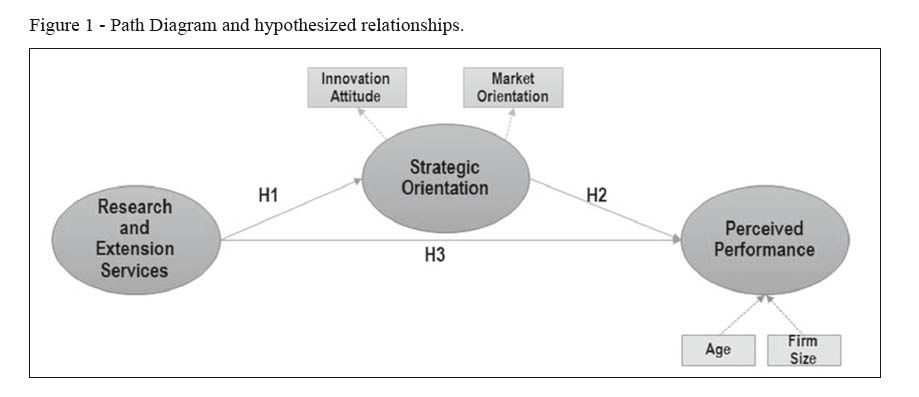
3. Survey characteristics and scales
Data were collected through a farmer survey (N = 247), administered in winter 2012-13 in the Valencia region. The size of the farms involved is mostly between 2 hectares and 5 hectares. Our target group was smallholders with at least 1 hectare of agricultural land, although we included livestock holdings occupying smaller areas. Our random sample was drawn from smallholders belonging to professional organizations. Participation in RES was not a pre-condition for inclusion in the sample so we do not expect significant selection bias.
The productive orientation of the region is mainly Mediterranean crops with a large presence of perennials including citrus and other fruit trees, vineyards and olive trees. The average age of the farmers in the sample was 48 years. The age groups considered were under 40 years old, between 40 and 65 years and over 65 years. Firm size was based on gross margins (< 5000 euros per year, 5000 to 20,000, and > 20,000). Table 1 shows that the sample includes mostly very small farms, although we control for age and farm size.
Reflective measures were used to evaluate the conceptual model depicted in Figure 1. Farmers were asked a series of questions in order to obtain an assessment of their SO, their evaluation of RES and their PP. We used a standard, Likert-type scale, ranging from “strongly disagree” (1) to “strongly agree” (7). The RES items were adapted from previous research by Segarra-Blasco and Arauzo-Carod (2008) and Schwartz and Hornych (2010), with the inclusion of some additional questions to evaluate farmers’ perceptions of agricultural research and innovation policies. A substantial set of the surveyed farmers consider public services and agricultural policy to be the RES tools of the least value for their activities (Figure 2). Advice services provided by private actors, such as cooperatives and input suppliers, universities and research centres, were rated more highly.
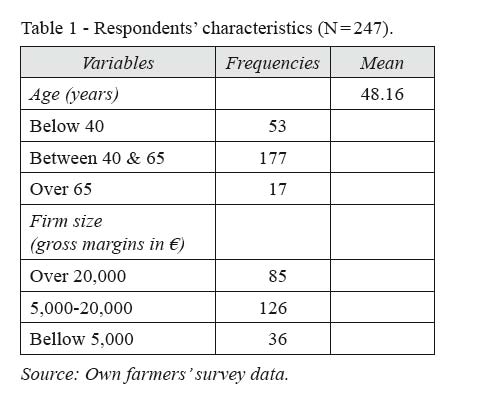
The SO construct was measured as a combined second-order construct of MO and IAT. MO scales were defined drawing on Narver and Slater’s (1990) work. IAT was measured based on Harrison et al. (1997) and Venkatesh and Davis (2000). Figure 3 reflects the higher values for scales related to quality, customer satisfaction, and innovativeness.
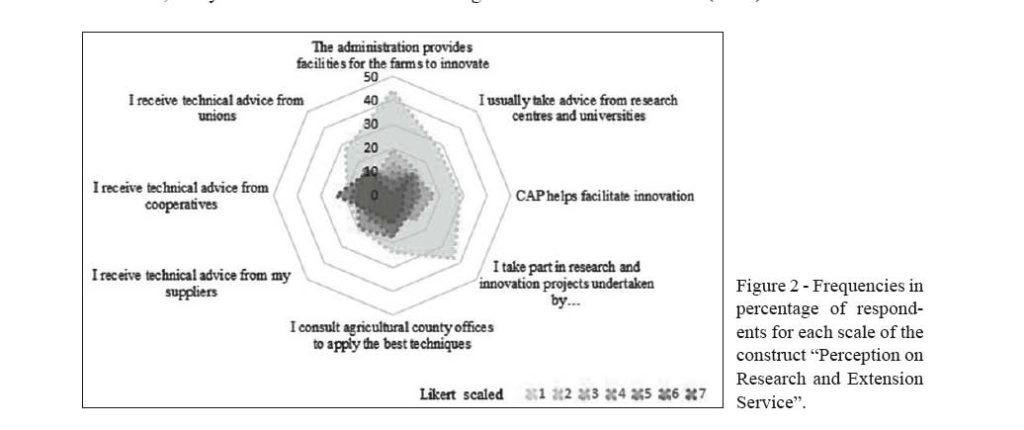
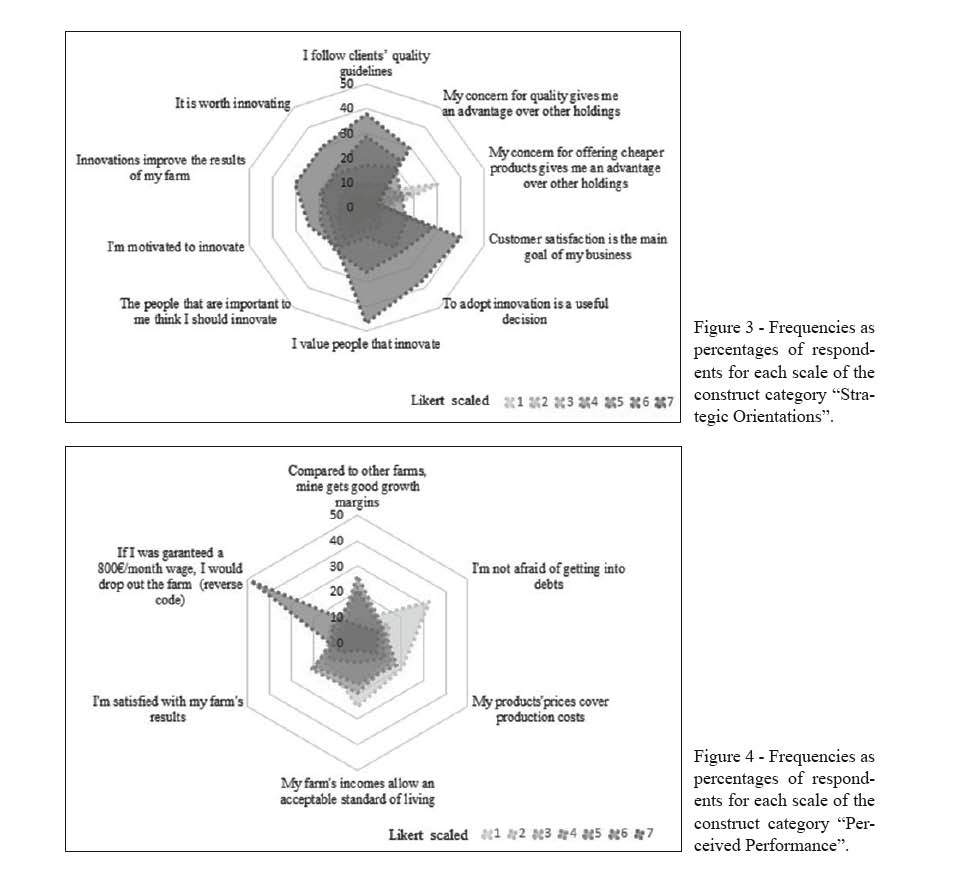
The PP scale draws on Fortuin and Omta (2009). It aims at exploring firm performance from a novel approach, which evaluates the benefits perceived by farmers. Figure 4 suggests that, on average, farmers are moderately satisfied with the performance of their farms. A significant percentage of respondents attached a relatively high score to the possibility of alternative jobs. Willingness to take on debts received the lowest score.
4. Method
The hypotheses proposed in Figure 1 include the whole system of variables and were tested statistically using SEM. This allows the model to fit with the data to be determined using the SPSS® Amos program. Exploratory Factor Analysis (EFA) indicates sample adequacy for each variable in our factors of interest, exploring the items (26) for the RES, SO and PO constructs, and determining the correlation among the variables in a dataset.
Confirmatory Factor Analysis (CFA) determines the factor structure of our dataset composed by the constructs: PP; RES and SO. The second order factor, SO, was built using the two first-order factors, MO and IAT. The factor loading of the main construct SO on its two sub-constructs (MO and IAT) was estimated, observing that all fitness indexes achieved the required level of consistence and the factor SO was well supported by the sub-factors MO & IAT.
The reliability, convergent and discriminant validity of the model needs to be assessed to reduce measurement errors (Hair et al., 2010). Table 2, for each component of the construct, displays the factor loading, the R-squared (R²). Reliability test (Cronbach’s alpha) and Average Variance Extracted (AVE).
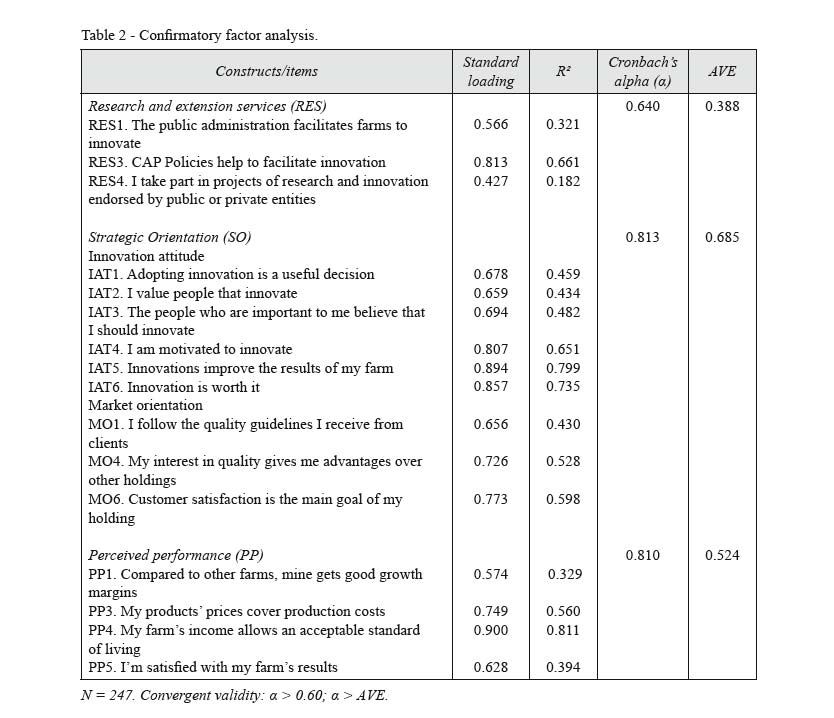
Reliability and validity
Items with the lowest factor loading (close to 0.0) were removed to improve the consistency of the model; where a variable has removed the reliability of the corresponding construct was examined. Deleting these items improves the model fit and does not significantly worsen the reliability of the model (Table 2). Internal consistent reliability of the constructs was measured by their Cronbach’s alpha (α) values, with α > 0.70 for most of the constructs except RES (α = 0.640). According to Nunnally (1978), in earlier research phases, α values > 0.60 are considered acceptable. The R² and the AVE reflect that a significant part of the variability is captured by the defined constructs. Although the individual result for RES (0.388) raises some concerns, discriminant and convergent validity can be accepted as values in the diagonal of the cross-construct correlation matrix, which shows AVE squared roots, are higher than the other values in the rows and columns (Table 3).

Global and individual measures
The global measurement model obtained from the CFA was estimated using Maximum Likelihood (ML). The specific indicators that determine the goodness of fit of the CFA model are: Chi-square (CMIN) = 163.020; Degrees of Freedom (DF) = 94; CMIN/DF = 1.734; Comparative Fit Index (CFI) = 0.959; Goodness of Fit Index (GFI) = 0.924 and Root-Mean-Square Error of Approximation (RMSEA) = 0.055. These indicators suggest that the dataset and the model show a satisfactory fit (Hair et al., 2010). The p-value is significant (p < 0.001); the reliability of global and individual tests is supported also by the sample size (> 200) and the results of a normality test run on the variables shows that the sample has a normal distribution. Therefore, we can evaluate the theoretical model through interpretation of the structural paths.
5. Findings and discussion
While we confirmed the adequacy of model fit measures in the CFA, each time a hypothesis is tested the model fit must be re-assessed. The SEM estimation using ML produced the following goodness of fit indicators: CMIN = 210.254; DF = 125; p < 0.001; CMIN/DF = 1.682; CFI = 0.951; GFI = 0.915; RMSEA = 0.053; all of these are adequate indicators of the SEM global measures.
The mediation relationship between RES and PP led by SO was tested based on the bootstrapping method with 2,000 bootstrap samples and a bias-corrected level of confidence of 90%. According to Hayes (2009), the bootstrap test is one of the better options to analyse the intervening variable effects. Table 4 shows the path diagram results broken down into the relationships between the independent and the dependent variables, corresponding to the direct effects proposed for our research model.
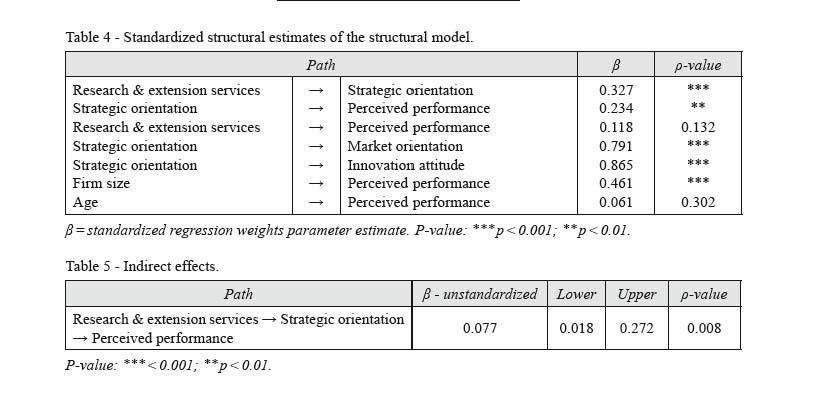
RES exerts a positive and significant effect on SO, confirming H1 (β = 0.327; p < 0.001). H2 is also confirmed; the results for SO and PP have a positive and significant relationship (β = 0.234; p < 0.01). However, the direct relationship between RES and PP is not significant (p = 0.132), which in this part of the analyses, corresponds only to the direct relationship without the mediating SO intervention. The second-order factor relationship measures (MO & IAT) are confirmed as positive and significant, which means no variation in the second-order factor CFA model after a re-examination of the path diagram in the SEM evaluation. We controlling effects of the age and firm size, and showed positive associations between firm size and PP.
The mediation test results are presented in Table 5. They reveal that PP is influenced positively by RES via SO (β-unstandardized = 0.077; p < 0.01). Following the typologies of mediation proposed by Zhao et al. (2010), we identify our model as indirect-only, where the indirect path (AXB) is significant and the direct effect (RES → PP) is not significant. Based on previous evidence about the positive relationships in H1 and H2, which also indicates a strong association, H3 is confirmed through the effect of SO.
Saeed et al. (2015) suggest a significant link between innovativeness and an optimistic perception of the firm, which is supported in our analysis by the positive and significant association between SO and PP. This finding confirms a way to improve PP that could be considered in innovation policy making. The SO in our model is composed of MO and IAT, which, in combination, show a positive association with farm performance. Our analysis also confirms a strong relationship between both sub-constructs, which represent intrinsic factors of farmer behaviour and effectiveness of RES adoption.
The path diagram in Figure 5 does not support a direct connection between RES and PP, so the use of RES has no clear effect on farmers’ perceptions of profitability. PP is affected more directly by the control variables and by SO.
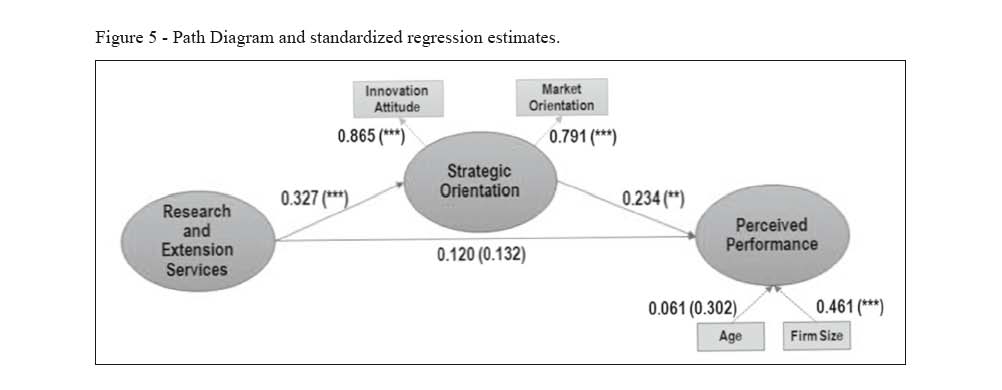
It seems that RES is not a determinant of farm profitability per se. In the region studied, Valencia, despite the presence of two public research centres (IVIA and CSIC) and a wide variety of public and private institutions (AKIS), universities and technology centres, what matters is how RES relates to performance. Klerkx and Proctor (2013) suggest that advisors and extension agents can optimize the effects of their work by engaging in “communities of practice” and responding to different types of queries, often through the exchange of tacit knowledge. Our results support the idea that SO is a basic mechanism that clarifies the link between the RES and PP. This suggests a role for the AKIS, which should be adapted to the technological needs of the most innovative and market-oriented farmers but should also cultivate strategic orientations.
6. Concluding remarks
EU innovation policy aims to «remove obstacles to innovation» and to «revolutionise the way the public and private sectors work together» (EU-SCAR, 2012).
The present paper proposes some methodological tools to assess the relationship between two key elements in the AKIS system, RES and farmers. We evaluated farmers’ perceptions, attitudes, and socioeconomic context to propose a novel approach in which strategic orientations are a core element of the system.
Our findings support the role of intermediation activities to improve farmers’ participation in the knowledge community, which is less accessible to smallholders than to large farmers (Castrogiovanni et al., 2012). Farmers in the studied area perceive services related to enhanced market innovation and quality in processes and production and other business strategies as the most valuable. Services provided by the public sector are not seen as very valuable (Moyano, 2017). We found a significant positive association of RES on SO, which is relevant to support innovation efforts in small farms with small financial capacities.
Innovation policy, at least in our regional context, needs to take account of the fact that a better PP is not determined only by use of RES, but also by how these services influence SO. The positive relationship between SO and PP confirms that innovativeness and market orientation improve the performance of small farms. Firm size is relevant, which implies that structural and rural development policies should continue to focus on achieving economic farm sizes.
The study confirms the perspective about the indirect influence of SO for enhancing the positive relationship between RES and PP, that could increase the effectiveness of the AKIS by attaching greater relevance to the enhancement of the social, organizational and behavioural elements of farms’ strategies (García Álvarez-Coque et al., 2016).
Our study has some limitations. Although our analysis suggests that AKIS could become more useful, the network of agents is more complex than depicted in our study. RES is a broad variable and PP may depend on the type of extension services received (public, private, R&D partnership) and the content of the training. Further investigations could enlarge the size of the sample and apply the method to different regional context. Finally, the RES is a construct that joins public and private services, and farmers could show a different behaviour depending on the type of service available in the local context. Effects on farm performance could depend on this specific types of RES.
While the survey provides a picture of farmers as knowledge users, they need to be considered also as knowledge suppliers from the perspective of the concept of communities of practice or operational groups, currently being promoted by the EIP-AGRI. The empirical analysis could be extended to other regional contexts in order to obtain more solid conclusions. However, we have shown, in a straightforward way that farm performance is enhanced by the contribution of the AKIS to SO attributes, mainly motivations and organizational innovations.
Acknowledgements
We acknowledge the support of the Project AGL2015-65897-C3-3-R funded by the Ministry of Economy and Competitiveness, for this research.
References
- Baker W.E. and Sinkula J.M., 2002. Market orientation, learning orientation and product innovation: delving into the organization’s black box. Journal of Market Focused Management.
- Baregheh A., Rowley J., Sambrook S., and Davies, D., 2012. Innovation in food sector SMEs. Journal of Small Business and Enterprise Development, 19(2): 300-321.
- Bhuian S., Menguc B. and Bell S., 2005. Just entrepreneurial enough: the moderating effect of entrepreneurship on the relationship between market orientation and performance, Journal of Business Research, 58: 9-17.
- Campbell J., 2014. Cooperate or compete: the relationship of strategic orientation and firm performance for farmers’ market vendors. Journal of Small Business Enterprises, 27(1): 27-42.
- Campbell J. and Park J., 2016. Extending the resource-based view: Effects of strategic orientation toward community on small business performance. Journal of Retailing and Consumer Services, 34: 1-7.
- Castrogiovanni G.J., Domenech J. and Mas-Verdú F., 2012. Variations in SME Characteristics and the Use of Service Intermediaries for R&D. Canadian Journal of Administrative Science, 29: 154-164. DOI: 10.1002/cjas.231.
- Claros E., 2014. Small Farms. Statistical Spotlight. European Parliamentary Research Service. Briefing 140794REV1. Online resource: http://www.europarl.europa.eu/.
- Diederen P., Van Meijl J. and Wolters A., 2003. Innovation Adoption in Agriculture: Innovators, Early Adopters and Laggards. Cahiers d’économie et sociologie Rurales, 67: 30-50.
- Dolinska A. and D’Aquino P., 2016. Farmers as agents in innovation systems. Empowering farmers for innovation through communities of practice. Agricultural Systems, 142: 122-130.
- Esparcia J., Mena M. and Escribano J., 2014. AKIS and advisory services in Spain. Report for the AKIS inventory (WP3) of the PRO AKIS project. Online resource: www.proakis.eu/ publicationsandevents/pubs.
- Eurostat, 2013. Agriculture, forestry and fishery statistics: 2013 edition. Accessible at: http://ec.europa.eu/eurostat/web/products-pocketbooks/-/KS-FK-13-001.
- EU-SCAR, 2012. Agricultural knowledge and innovation systems in transition – A reflection paper. Brussels. DOI: 10.2777/34991.
- FAO, IFAD and WFP, 2015. The State of Food Insecurity in the World 2015. Meeting the 2015 international hunger targets: taking stock of uneven progress. FAO, Rome.
- Fernandes C., Ferreira J. and Marques C., 2013. Innovation management capabilities in rural and urban knowledge intensive business services: empirical evidence. Service Business, 1-24.
- Fortuin F., Omta S., 2009. Innovation drivers and barriers in food processing. British Food Journal, 111(8): 839-851.
- García Álvarez-Coque J.M., Mas-Verdú F. and Roig-Tierno N., 2016. Technological innovation versus non-technological innovation: different conditions in different regional contexts? Quality and Quantity, DOI: 10.1007/s11135-016-0394-2.
- García Álvarez-Coque, J.M., Mas-Verdú F. and Sanchez-García M., 2015. Determinants of Agri-food Firms’ Participation in Public Funded Research and Development. Agribusiness, 31(3): 314-329.
- Gorton M. and Davidova S., 2004. Farm productivity and efficiency in the CEE applicant countries: A synthesis of results. Agricultural Economics, 30(1): 1-16.
- Graeub B.E., Chappell M.J., Wittman H., Ledermann S., Kerr R.B. and Gemmill-Herren B., 2016. The state of family farms in the world. World development, 87: 1-15.
- Hair J., Black W., Babin B. and Anderson R., 2010. Multivariate data analysis, 7th ed., Chapter 11. Upper Saddle River, New Jersey, USA: Prentice-Hall, Inc.
- Hansson H., 2008. How can farmer managerial capacity contribute to improved farm performance? A study of dairy farms in Sweden. Food Economics – Acta Agriculturae Scandinavica, Section C5(1): 44-61.
- Harrison D., Mykytyn P. and Riemenschneider C., 1997. Executive decisions about adoption of information technology in small business: Theory and empirical tests. Information System Research, 8(2): 171-195.
- Hayes A., 2009. Beyond Baron and Kenny: Statistical Mediation Analysis in the New Millennium. Communication Monographs, 76(4): 408-420.
- Huergo E., Trenado M. and Ubierna A., 2015. The impact of public support on firm propensity to engage in R&D: Spanish experience. Technological Forecasting and Social Change, 206-219.
- Klerkx L. and Leeuwis C., 2008. Establishment and embedding of innovation brokers at different innovation system levels: Insights from the Dutch agricultural sector. Technological Forecasting & Social Change, 76(6): 849-860.
- Klerkx L. and Proctor A., 2013. Beyond fragmentation and disconnect: Networks for knowledge exchange in the English land management advisory system. Land Use Policy, 30(1): 13-24.
- Knickel K., Brunori G., Rand S. and Proost J., 2009. Towards a better conceptual framework for innovation processes in agriculture and rural development: From linear models to systemic approaches. Journal Agricultural Education and Extension, 15(2): 131-146.
- Knierim A., Boenning K., Caggiano M., Cristóvão A., Dirimanova V., Koehnen T., Labarthe P. and Prager K., 2015. The AKIS concept and its relevance in selected EU member states. Outlook on Agriculture, 44(1): 29-36.
- Labarthe P., 2009. Extension services and multifunctional agriculture. Lessons learnt from the French and Dutch contexts and approaches. Journal of Environmental Management, 90(2): 193-202.
- Labarthe P. and Laurent C., 2013. Privatization of agricultural extension services in the EU: Towards a lack of adequate knowledge for small-scale farms? Food Policy, 38: 240-252.
- Läpple D., Renwick A. and Thorne F., 2015. Measuring and Understanding the Drivers of Agricultural Innovation: Evidence from Ireland. Food Policy, 51: 1-8.
- Mas-Verdú F., Wensley A., Alba M. and Álvarez-Coque J.M., 2011. How much does KIBS contribute to the generation and diffusion of innovation? Service Business, 5(3): 195-212.
- Mavondo F., Chimhanzi J. and Stewart J., 2005. Learning orientation and market orientation: relationship with innovation, human resource practices and performance. European Journal of Marketing, 39(11/12): 1235-1263.
- McCown R., 2002. Changing systems for supporting farmers’ decisions: problems, paradigms, and prospects. Agricultural Systems, 74(1): 179-220.
- McLeay S. and Fieldsend J., 1987. Sector and size effects in ratio analysis: An indirect test of ratio proportionality. Accounting and Business Research, 17(66): 133-140.
- Micheels E. and Gow H., 2014. The effect of market orientation on learning, innovativeness, and performance in primary agriculture. Canadian Journal of Agricultural Economics, (00): 1-25.
- Moyano P., 2017. La implicación de los agentes sociales y económicos en el desarrollo rural: una necesidad insatisfecha. Economía Agraria y Recursos Naturales – Agricultural and Resource Economics, 17(2): 55-79. DOI: https://doi.org/10.7201/earn.2017.02.3.
- Muller E. and Zenker A., 2001. Business services as actors of knowledge transformation: the role of KIBS in regional and national innovation systems. Research Policy, 30(9): 1501-1516.
- Narver J.C. and Slater S.F., 1990. The effect of a market orientation on business profitability. Journal of Marketing, 54(4): 20-35.
- Nunnally J.C., 1978. Psychometric theory, 701. New York: McGraw-Hill.
- O’Donoghue C. and Heanue K., 2016. The Impact of Formal Agricultural Education on Farm Level Innovation and Management Practices. The Journal of Technology Transfer. doi.org/10.1007/s10961-016-9529-9.
- Pascucci S. and De Magistris T., 2012. Factors affecting farmers’ likelihood to use advisory and extension services. New Medit, 11(3): 2-11.
- Ramos-Sandoval R., García Álvarez-Coque J.M. and Mas-Verdú F., 2016. Innovation behaviour and the use of research and extension services in small-scale agricultural holdings. Spanish Journal of Agricultural Research, 14(4): 1-14.
- Rosenbusch N., Brinckmann J. and Bausch A., 2011. Is innovation always beneficial? A meta-analysis of the relationship between innovation and performance in SMEs. Journal of Business Venturing, 26(4): 441-457.
- Saeed S., Yousafzai S., Paladino A. and De Luca L., 2015. Inside-out and outside-in orientations: A meta-analysis of orientation’s effects on innovation and firm performance. Industrial Marketing Management, 47: 121-133.
- Sánchez-Zamora P., Gallardo R. and Ceña F., 2014. El medio rural andaluz frente a la crisis económica: Un análisis de los factores de resiliencia territorial. Economía Agraria y Recursos Naturales – Agricultural and Resource Economics, 14(1): 27-56.
- Schwartz M. and Hornych C., 2010. Cooperation patterns of incubator firms and the impact of incubator specialization: Empirical evidence from German. Technovation, 30: 485-495.
- Segarra-Blasco A. and Arauzo-Carod J., 2008. Sources of innovation and industry-university interaction: evidence from Spanish firms. Research Policy, 37: 1283-1295.
- Sirén Ch., Hakala H., Wincent J. and Grichnik D., 2016. Breaking the Routines: Entrepreneurial Orientation, Strategic Learning, Firm Size, and Age. Long Range Planning. In press: http://dx.doi.org/10.1016/j.lrp.2016.09.005.
- Sutherland L., Madureira L., Dirimanova V., Bogusz M., Kania J., Vinohradnik K., Creaney R., Duckett D., Koehnen T. and Knierim A., 2017. New knowledge networks of small-scale farmers in Europe’s periphery. Land Use Policy, 63: 428-439.
- Toma L., Barnes A., Sutherland L., Thomson S., Burnett F. and Mathews K., 2016. Impact of information transfer on farmers’ uptake of innovative crop technologies: A Structural Equation Model applied to survey data. The Journal of Technology Transfer. doi.org/10.1007/s10961-016-9520-5.
- Ton G., Klerkx L., de Grip K. and Rau M., 2015. Innovation grants to smallholder farmers: Revisiting the key assumptions in the impact pathways. Food Policy, 51: 9-23.
- Venkatesh V. and Davis F., 2000. A theoretical extension of the technology acceptance model: four longitudinal field studies. Management Science, 45(2), 186-204.
- Verhees F., Meulenberg M. and Pennings J., 2010. Performance expectations of small firms considering radical product innovation. Journal of Business Research, 63: 772-777.
- Werr A. and Stjernberg T., 2003. Exploring management consulting firms as knowledge systems. Organisation Studies, 24: 881-908.
- Wiklund J. and Shepherd D., 2005. Entrepreneurial orientation and small business performance: a configurational approach. Journal of Business Venturing, 20(1): 71-91.
- Wright P., Kroll M., Pray B. and Lado A., 1995. Strategic orientations, competitive advantage, and business performance. Journal of Business Research, 33: 145-151.
- Zagata L. and Sutherland L., 2015. Deconstructing the “young farmer problem in Europe”: towards a research agenda. Journal of Rural Studies, 38: 39-51.
- Zhao X., Lynch J. and Chen Q., 2010. Reconsidering Baron and Kenny: Myths and Truths about Mediation Analysis Source. The Journal of Consumer Research, 37(2): 197-206.











